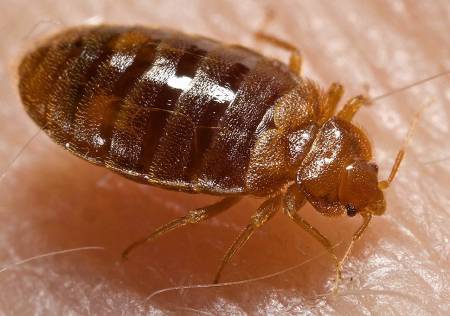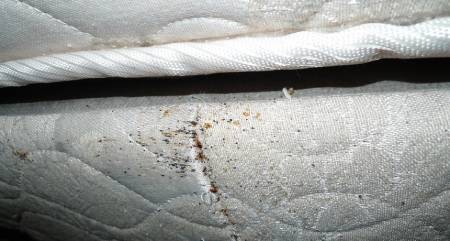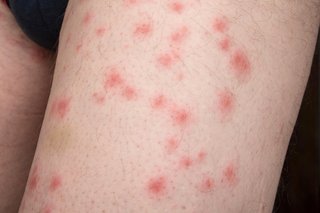


Bed Bugs are small, oval, brown insects that feed on the blood of animals or humans. Adult bed bugs have flat bodies about the size of an apple seed. After feeding, however, their bodies swell and become a reddish color.
Bed Bugs do not fly, but they can move quickly over floors, walls, and ceilings. Female bed bugs may lay hundreds of eggs, each of which is about the size of a speck of dust, over a lifetime.
Although they are a nuisance and cause often itchy bites, they are not believed to transmit diseases.
Bed bugs may enter your home undetected through luggage, clothing, beddings and couches, and other items. Their flattened bodies make it possible for them to fit into tiny spaces. Bed bugs do not have nests, but tend to live in groups in hiding places. Their initial hiding places are typically in and around mattresses, bed frames, and headboards where they have easy access to people to bite in the night.
Over time, however, they may scatter through the bedroom, moving into any crevice. They may also spread to nearby rooms or apartments.
Because bed bugs live solely on blood, having them in your home is not a sign of dirtiness. You are as likely to find them in perfectly clean homes and hotel rooms as in filthy ones.
Bed bugs are active mainly at night and usually bite people while they are asleep. They feed by piercing the skin and withdrawing blood through an elongated beak.
Most bed bug bites are painless at first but later turn into itchy welts. Bedbug bites are on any area of skin exposed while sleeping.
People who don’t realize they have a bedbug infestation may attribute the itching to other causes, such as mosquitoes. To confirm bedbug bites, you must find and identify the bugs themselves.
If you suspect an infestation, remove all bedding and check it carefully for signs of the bugs or their excrement. Remove the dust cover over the bottom of the box springs and examine the seams in the wood framing. Peel back the fabric where it is stapled to the wood frame.
Also, check the area around the bed, including inside books, telephones or radios, the edge of the carpet, and even in electrical outlets. Check your closet, because bed bugs can attach to clothing. If you are uncertain about signs of bed bugs, call Greencare, who will help you identify and control bedbug infestations.


Bed bugs have extremely strong instincts. These instincts allow them to resist the allure of food during the daytime when their prey could spot them. Bed bugs only come out of hiding when the smell of exhaled carbon dioxide gets too strong to resist. That usually happens in the evening, when you’re sleeping.
Bed bugs are not limited to any one specific type of dwelling. We have seen infestations everywhere including homes, hotels, hospitals, schools, dormitories, office buildings, retail stores, movie theaters, and even public transportation. Even five-star hotels and high-end clothing stores are not spared from infestation.
Bed bugs should not be equated with filth or sanitation problems. Bed bugs are very elusive, transient pests. And they are hardy. They can live for several months without eating and can withstand a wide range of temperatures from nearly freezing to 50 degrees Celsius. Bed bugs can be controlled with vigilance, constant inspection, and treatment by professional pest control companies like Greencare.
To prevent bedbug infestations, you need to be vigilant in assessing your surroundings. When returning from a trip, check your luggage and clothing. If you think you may have a bed bug infestation, contact us. This is often not a pest that can be controlled with do-it-yourself measures.
Bed bugs are not just found in beds. They can be in chair cushions, sofas, behind electrical outlets, cracks and crevices, or even behind picture frames. In other words, they can be live pretty much anywhere.
Bed bugs are not known to spread any diseases to humans. However, their bites can leave behind itchy, red welts which can become infected from scratching.
If you cannot find the answer to your question in our FAQs, you can always Contact Us . We will answer you shortly!